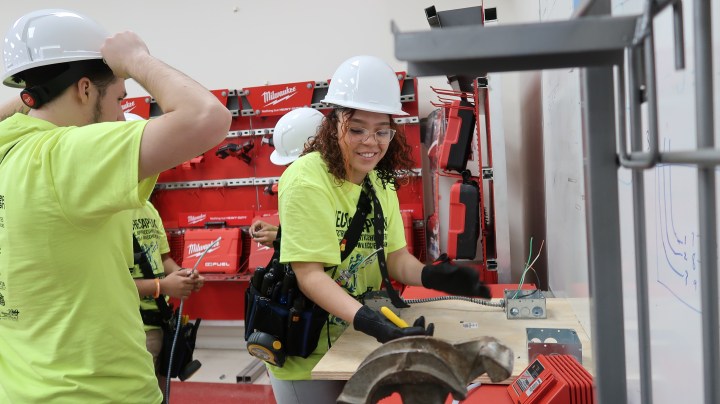
A labor shortage stands in the way of the clean energy transition
A labor shortage stands in the way of the clean energy transition

Labor shortages have been pretty common throughout this pandemic recovery economy, but a growing shortage of skilled tradespeople could slow down efforts to shift to a green energy economy.
Last year’s federal Inflation Reduction Act is supposed to channel hundreds of billions of dollars into clean energy projects in an effort to transition homes and businesses away from fossil fuels. That includes increasing the availability of renewable power sources and “electrifying America.”
But even before this influx of funding from the IRA, the U.S. was short the number of electricians needed to build out that infrastructure.
“A lot of the labor force in skilled trades is older and is retiring. And that’s just a natural fact of life,” said Joshua Hawley, a professor at Ohio State University who researches workforce development. “And then they’re not being replaced at the same rate.”
According to the Bureau of Labor Statistics, the U.S. currently needs about 80,000 new electricians every year. But those in the field say filling those jobs is going to be exceptionally difficult.

“Experienced electricians are impossible to find,” said Mark Dols, vice president of M.R. Electricians in Rockville, Maryland. He has almost three dozen electricians on staff, several apprentices in training and is expanding the business in Florida.
Dols said his company offers competitive salaries, even for people with no experience, plus on-the-job-training and company-paid tuition for additional school; vacation, 401(k), life insurance, health insurance and other perks.
“I have electricians that work for me that make over $100,000 a year,” he said. “They’re doing very well. I mean, they’re making very, very good livings.”
And yet, Dols still has difficulty recruiting. “We just purchased another electrical contractor because we couldn’t find people,” he said. “So we purchased another contractor, basically, just for their manpower.”
He said one of the issues preventing more people from entering the training pipeline is societal stigma about so-called blue-collar work.
“For quite a while, it’s been viewed that … we’re not intelligent. You do grunt work. And it’s the furthest thing from the truth,” he said.
Dols and his company are part of Independent Electrical Contractors Chesapeake, an apprenticeship and training organization with multiple locations in the mid-Atlantic region.
One of its programs gives local high school students a jump-start on electrician training, partnering them with local businesses and setting them on a path to apprenticeships.

“It’s the best opportunity that I’ve gotten so far for what I want to do with my life,” said 17-year-old Melvin Copple, who has been with IEC since February. He said his school counselor told him about the program, and it seemed a good fit since he still hasn’t quite decided on a career. Plus, he liked the idea of not having to take on debt to start his career training.
“They pay for all the schools,” Copple said. “Like whatever job you go into — so making money and free school.”
But Copple and young people like him are in short supply.
It’s often not the students themselves who balk at going into trades, said Paula Bahler, the workforce development manager at IEC Chesapeake. Rather, it’s their parents.
“If you are generations of family that’s going to college, you think that’s the path for the next one in line,” she said. “Everybody wants an electrician, but they want somebody else’s kid to be their electrician.”
Bahler warned that the electrician shortage will make all those IRA projects cost more and take longer to get done.
“It’s going to raise the wage, but it won’t only raise the wage for the best electricians,” Bahler said. “It’ll raise the wage for all electricians because you’re going to need bodies on job sites.”
The shortage might not be so noticeable at first, said Joshua Hawley at Ohio State — especially on some of the marquee projects connected with IRA funding.
“If you’re going to build a battery plant, you’re going to attract, you know, a couple billion dollars’ investment, [and] you’re probably going to be able to pay the wages that are going to attract the skilled labor,” he said.
But when it comes to smaller projects, like installing solar panels on businesses, heat pumps in homes, vehicle charging stations at apartment buildings and other electrification projects, Hawley said it will be much harder to find trained workers.

So Paula Bahler is recruiting heavily, trying to get more students interested in the trades. She said it can be particularly challenging to recruit women, although she has had some luck.
Mia Clay, 18, is one of just a handful of girls in the IEC program and acknowledges she stands out a bit in her class.
“I look, like, pretty girly, but I like to do things with my hands. Like, I’m gonna do it. I’m a hard worker.”
Clay said one reason she wants to become an electrician is that she anticipates making enough money to allow her to live comfortably and independently. And she doesn’t intend to conform to any stereotype of the role.
“I don’t have to change myself just to be in the field,” she said. “I don’t I feel like I have to make myself, like, less feminine to be in the field.”
To fill all the green energy jobs that are coming, the field needs many more Mia Clays — and soon.
Additional reporting by Trina Mannino.
There’s a lot happening in the world. Through it all, Marketplace is here for you.
You rely on Marketplace to break down the world’s events and tell you how it affects you in a fact-based, approachable way. We rely on your financial support to keep making that possible.
Your donation today powers the independent journalism that you rely on. For just $5/month, you can help sustain Marketplace so we can keep reporting on the things that matter to you.











